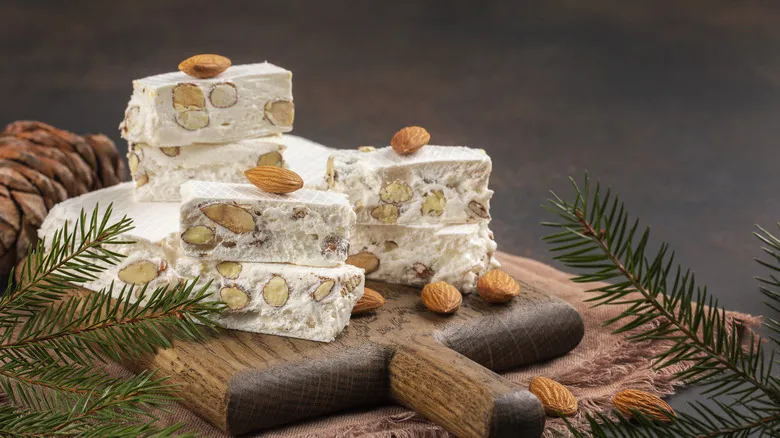What is nougat?
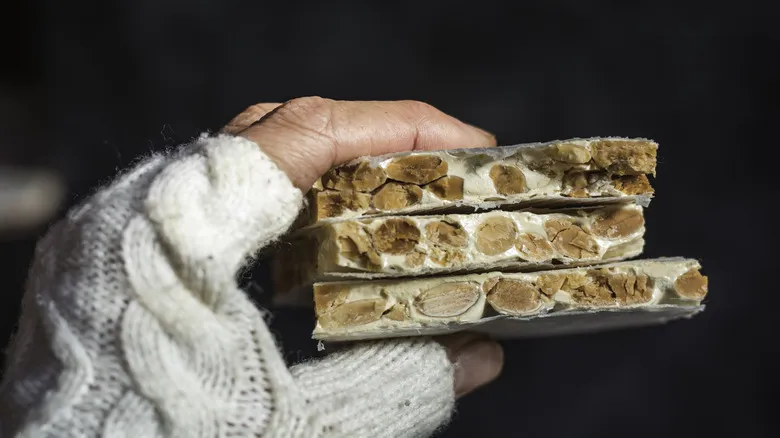
Nougat is a light and airy treat, placing it alongside marshmallows, sponge cake, and taffy. It comes in various forms, ranging from artisanal creations to candy bars, and even vibrant homemade varieties filled with candied fruits or nuts, often cut into small white squares. The base ingredients for nougat include honey and sugar, although more affordable versions may use corn syrup and other additives. Similar to meringue preparation, the process of whipping egg whites during nougat production introduces air, contributing to its fluffy texture. Typically, nougat is enhanced with nuts or additional ingredients like dried fruits, citrus, or cocoa.
The flavor of nougat is sweet and sticky, with textures that can vary from soft and chewy to firm and brittle. While most nougat is white, there are also lesser-known black varieties made with cocoa. Although the ingredients for soft and hard nougat are often similar, the cooking temperature is adjusted to achieve the desired level of firmness.
We spoke with A.J. Sarno about why nougat stands out among the myriad of sweets available. He explains that nougat "blends the sweetness and richness of honey with a nutty element, primarily from almonds and pistachios. For those who prefer less sugary treats, it’s a fantastic choice." Traditional nougat, such as torrone, made with authentic methods and ingredients, offers a delightful sweetness without the excessive artificial sweetness found in many commercial candy bars. Sampling a traditional piece is a worthwhile experience to appreciate the difference.
A history of nougat

Nougat is a time-honored delicacy that dates back at least a millennium. According to legend, the term nougat derives from the Latin phrase nux gatum, meaning nut pie. In ancient Rome, it was common to consume honey, nuts, and eggs, and it is believed that the Romans combined nuts and honey to create a portable snack that could withstand the test of time, as honey has an indefinite shelf life. The earliest documented reference to nougat appears in Arabic texts from Baghdad in the 900s, describing a confection known as natif or native, which is said to have originated in Harran, present-day Turkey, around the same period.
Nougat made its way to Spain from the Middle East during the Arab rule of the Iberian Peninsula, which lasted from 711 to 1492. It later arrived in Italy in the 1400s and France in the 1600s. Notably, Nostradamus included a nougat recipe in his 1555 cookbook, *Traité des fardements et confitures* (Treatise on Makeup and Jams), attributing its origins to Italy.
As nougat spread across Europe, each nation developed its own unique version using local ingredients. Spain produced turrón, Italy created torrone (also referred to as mandorlato, named after the almond), and by the 1700s, France had developed its signature nougat de Montélimar in the town of Montélimar in southeastern France. Today, traditional nougat can be found alongside commercially made varieties in candy bars and other contemporary confections.
How is nougat made?
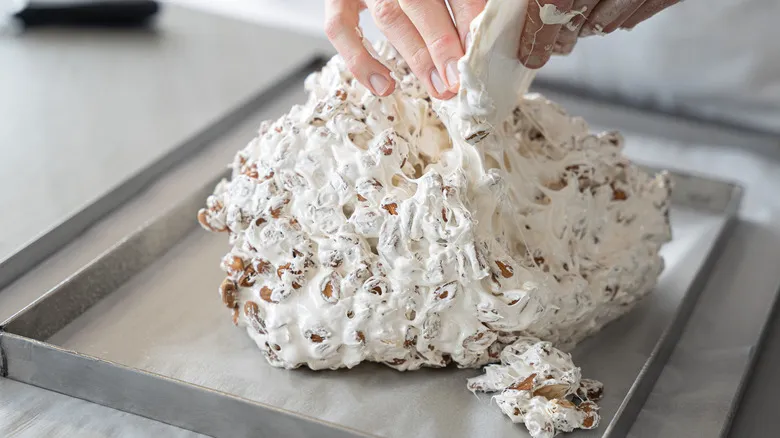
The method for crafting traditional nougat has remained largely unchanged over the centuries. The ingredients are straightforward, so optimal results depend on using high-quality components and meticulous attention to the process. Whipping the egg whites is particularly crucial. While this was once done by hand, it is now typically performed mechanically until the volume doubles.
A.J. Sarno shares the process of making Italian torrone at his bakery. They begin by gently heating honey and sugar together. For soft torrone, the mixture is cooked until it reaches 230 degrees Fahrenheit. At that point, powdered sugar is incorporated while the cooking continues. The next step involves folding in the whipped egg whites, followed by the addition of nuts—specifically almonds and pistachios in Sarno's recipe. Sarno notes that the ingredients for both soft and hard torrone are identical, consisting of honey, sugar, egg whites, and nuts. "The distinction between hard and soft lies in how the ingredients are prepared," he explains. "Hard torrone is made by cooking the honey and sugar to a higher temperature, while soft torrone is cooked to a lower temperature to achieve its chewy consistency."
Once the ingredients are cooked, whipped, and combined, the nougat mixture is poured into a pan to set for several hours before being sliced and packaged. Torrone is placed between two layers of pastry wafers, so be sure to line the pan with the first layer before pouring in the mixture.
What is traditional nougat?
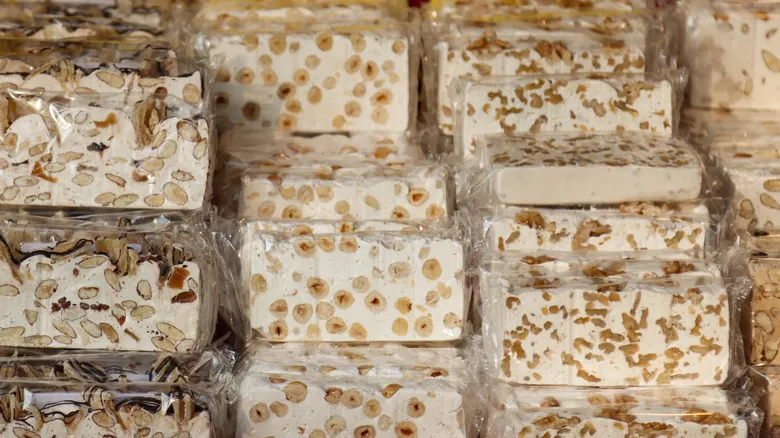
Traditional nougat, commonly found in various parts of the world like Europe, is available in specialty shops across the U.S. Here, nougat is more often encountered as a soft, fluffy, and sweet layer within candy bars. For instance, consider the base of a Snickers bar beneath the peanuts or the entire filling of a 3 Musketeers.
This classic nougat holds cultural significance and is crafted from simple, high-quality ingredients. The methods used to make it have been handed down through generations and remain largely unchanged. The result is a nougat that boasts a pure flavor and a delightful texture, being both fluffy and dense simultaneously. It is often enjoyed as a standalone treat, such as a slice at the conclusion of a festive meal.
While we have certainly indulged in our fair share of mass-produced candy bars, we must acknowledge that they offer a different experience. This type of nougat is typically incorporated into other recipes, like candy bars, and tends to have an artificially sweet taste that lacks the authentic flavor and textural richness of the original. The ingredients also differ significantly. Mass-produced candy bars are not made from all-natural components; they often include corn syrup, hydrolyzed protein, soy lecithin, and preservatives to achieve a consistent fluffy nougat texture, reduce costs, and extend shelf life. If you're uncertain about what you're consuming, it's wise to check the expiration date, as traditional natural nougat is only good for a few weeks.
The three main kinds of nougat
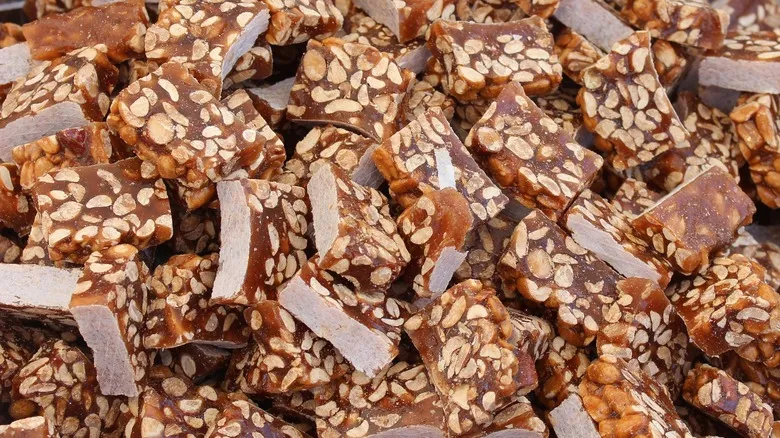
Nougats, such as Italian torrone and Persian gaz, are typically white, but they actually come in three primary varieties: white, black, and Viennese, also referred to as German nougat. White nougat, made with egg whites, honey, and sugar, has a light hue that serves as a perfect base for adding nuts or dried fruits. Its texture can range from soft and fluffy to hard.
Black nougat, on the other hand, is a thin, dark, and brittle variety. Lacking egg whites, it does not have the fluffiness of white nougat and is significantly harder. While it shares similar ingredients with white nougat, it is prepared differently; the sugar is cooked at a high temperature until it caramelizes. The dark color may also be derived from ground hazelnuts or cocoa powder.
Italy produces a dark version of torrone that incorporates hazelnuts, some of which are ground and mixed with sugar, while others remain whole within the confection. If you decide to make this at home, be sure to roast the hazelnuts beforehand to enhance their flavor. Dark nougat is also crafted in France and may include almonds in addition to hazelnuts. Nougatine, a type of French black nougat, is notably thin and brittle. Despite its name, Viennese or German nougat is quite different; it is a soft, fudgy mixture of hazelnuts, chocolate, butter, powdered sugar, and salt, which can be enjoyed on its own or used as a filling for chocolate pralines.
How to make nougat at home
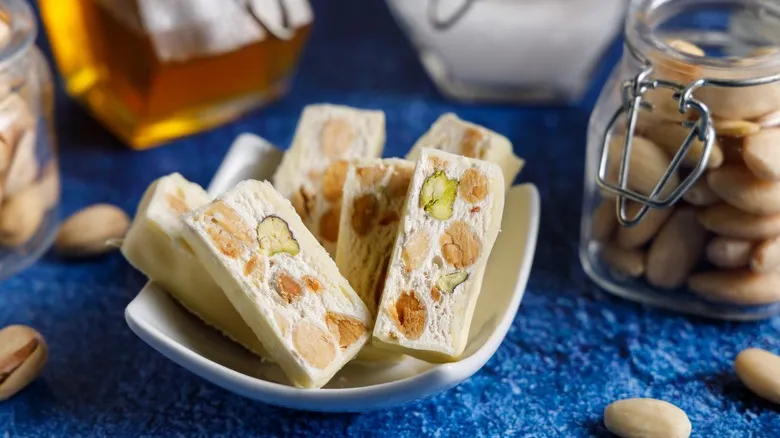
"Torrone can easily be prepared at home with just a pot and a stove," explains A.J. Sarno. Although the process isn't overly complex, it's crucial to familiarize yourself with the steps beforehand and to work swiftly for a successful outcome. Having a few essential tools on hand will also be beneficial. A candy thermometer is necessary to monitor the sugar's temperature, as it needs to reach a specific degree to transform into syrup. A stand mixer will simplify the task of whipping the egg whites and incorporating the sugar syrup, which is vital for achieving the fluffy texture of nougat, as the egg whites must be whipped to double their original volume.
Once that’s done, nuts and other ingredients are gently folded in. To prevent the sticky mixture from adhering to your spatula or spoon, it's helpful to grease them beforehand. Finally, pour the mixture into a greased or lined pan and allow it to cool for several hours before slicing it into your desired shapes or sizes.
Opt for the highest quality ingredients, particularly the honey, as its flavor can vary significantly based on quality. You can use almonds, hazelnuts, or pistachios (don’t forget this quick pistachio opening tip) based on your preference, and toasting them beforehand will enhance their flavor. Gather some water, sugar, and egg whites, and you’ll be ready to create a classic traditional nougat.
Where to buy nougat

If you're curious about where to find traditional nougat, you're not the only one. In December, if you happen to be in certain European countries, nougat can be easily found in candy shops, farmers' markets, and regular supermarkets. Unfortunately, this abundance of artisanal nougat isn't as accessible in the U.S. Here, it's much simpler to come across candy bars that contain mass-produced nougat. While you might find pre-sliced, individually wrapped commercial nougat in American supermarkets during the holiday season in select areas, for a truly indulgent artisanal experience, it's best to go directly to the source.
We spoke with A.J. Sarno about where to find it locally. "Nougat, known as torrone in Italian culture, is a treat typically enjoyed during the holiday season," Sarno explains. "You can find torrone in most Italian bakeries and specialty food stores around the holidays. We only produce torrone during this time because the warmer months prevent it from setting properly."
Some artisan producers, like Sarno, offer shipping across the country, so ordering from them is a viable option if you're not nearby. In addition to Italian markets and bakeries, consider checking out gourmet grocery stores or international markets, which are often found in many cities. If there's one in your vicinity, a Middle Eastern grocery store may have Persian gaz. Traditional nougat can also be purchased online from overseas, but be mindful of the shipping costs.
Nougat nutritional information
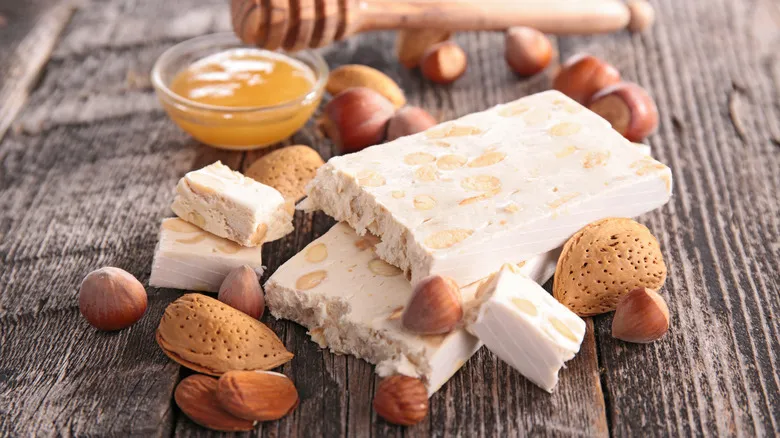
Savoring nougat in moderation is wise, primarily due to its sugar content. Finding nutritional information can be challenging since there are numerous varieties, often crafted by local independent producers, many of whom are located overseas. Ferrara is a brand that offers packaged torrone filled with almonds and infused with vanilla and citrus, commonly found in US supermarkets during the holiday season. A serving of three pieces, or 36 grams, contains 168 calories, 7 grams of fat, 3 grams of protein, and 23 grams of sugar.
While we hesitate to label a sugar-based confection as healthy, traditional or artisanal nougat (the purer, the better) can be a reasonable choice for a sweet indulgence due to the high-quality, natural ingredients used. If the product has a short shelf life, it’s a good indication that it lacks artificial preservatives.
Additionally, you can benefit from some ingredients known to promote health. If you can find an artisanal version made with honey, this natural sweetener is rich in antioxidants and polyphenols, which combat free radicals and reduce inflammation. Honey also possesses significant antibacterial properties and can assist individuals with diabetes in managing their blood sugar levels. Although nuts are high in fat and calories, they are an excellent source of fiber and essential nutrients like selenium, manganese, copper, and magnesium. They are also packed with antioxidants and can aid in reducing inflammation, managing weight and type 2 diabetes, and lowering cholesterol levels.
Middle Eastern nougat
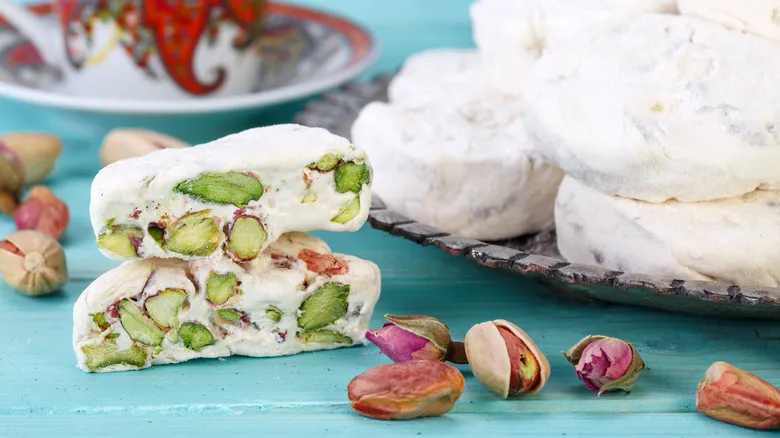
The earliest known nougat recipe dates back to 10th century Baghdad and features a diverse array of ingredients. In addition to honey and egg whites, it includes spices such as cloves and cinnamon, along with dried coconut, almonds, pistachios, and hemp seeds. This recipe is referred to as "natif," which translates to "dribble." In many Arabic countries today, this sweet treat is called "mann al sama." Unlike its European versions, this confection incorporates unique flavorings, including cardamom. If you haven't tried it yet, cardamom is a spice worth adding to your culinary repertoire. Its flavor is described as warm, complex, peppery, minty, citrusy, and floral, making it a delightful enhancement to nougat. Additionally, Middle Eastern nougat is distinguished by the inclusion of rosewater in its ingredients.
Iranian gaz is a renowned Persian variety of nougat. This simple yet flavorful sweet has been cherished for centuries as part of the region's rich culinary heritage. Originating from the province of Isfahan, it has become one of the most sought-after souvenirs for tourists visiting the area. Unlike other types of nougat that use honey, gaz was originally made from the sap of the tamarisk tree, though it is now commonly prepared with sugar and liquid glucose. This soft and chewy nougat features ingredients such as almonds, pistachios, egg whites, rose water, and spices like saffron. It is closely associated with Persian hospitality and is often served alongside tea.
European varieties of nougat
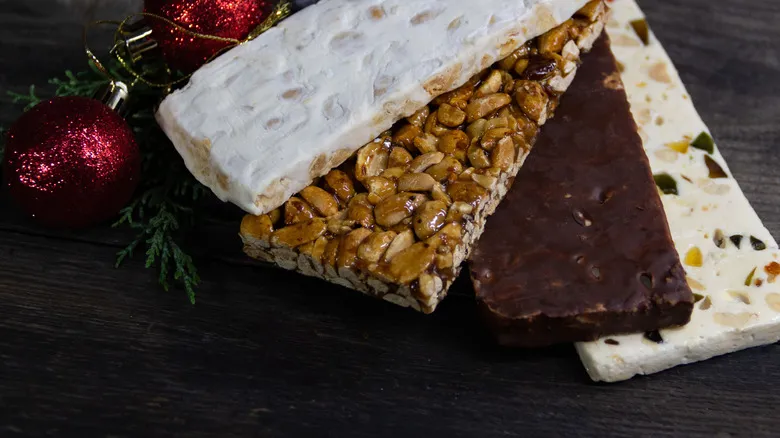
European nougats are closely linked to the Christmas season. The roots of Spanish turrón can be traced back to the Moors, whose culinary traditions significantly influenced the local population during their nearly thousand-year rule over the Iberian Peninsula. One enduring recipe is turrón, which comes in two primary varieties: turrón de Alicante, a hard version, and Jijona turrón, which is soft.
In France, both white nougat and dark nougatine are produced, with nougat de Montélimar being a renowned variety from the city of Montélimar in the Drôme Provençal region of southern France. This delicacy is crafted from honey and almonds, which thrive in the area. For centuries, it has been a staple of the region's Christmas menus, often featured as one of the 13 desserts, most of which include white nougat (symbolizing good) or dark nougat (symbolizing evil).
Italian torrone, also referred to as mandorlato, is a well-known Italian confection enjoyed internationally, and it is the type that A.J. Sarno produces in his bakery. This version is unique as it is layered between two sheets of wafer paper. Regarding flavor, Sarno notes, "The base of torrone is honey; we use clover honey, which provides a sweet richness that blends beautifully with the nuttiness of almonds and pistachios." He adds that while the base for torrone remains consistent, a variety of nuts or dried fruits can be incorporated according to personal preference. Additional fillings may include vanilla, citrus zest, cinnamon, and chocolate.
How to store nougat

Candy bars that include nougat have a lengthy shelf life, but traditional nougat does not contain the preservatives found in mass-produced varieties. The individual ingredients of traditional nougat are relatively stable. When stored correctly in the refrigerator, nuts can last a long time, and honey is known to remain good for centuries. While we’re uncertain about trying it, 3,000-year-old honey discovered in ancient Egypt was still edible.
However, when these ingredients are combined to create nougat, the shelf life decreases. Depending on the specific ingredients and manufacturing processes, some vacuum-packed commercial nougat can last around a year. If you're fortunate, you might find these options even outside the holiday season. On the other hand, artisanal nougat made without preservatives has a shorter shelf life, typically around two months for an unopened package, though this can vary by type. Italian torrone, for instance, is generally more fragile than other varieties. A.J. Sarno notes that if stored properly in an airtight container, torrone can last about a month. That’s useful information, but we’re skeptical about being able to resist finishing it sooner.
Once the package is opened, it’s best to consume the nougat within a couple of weeks. To keep it at its best, store it in a cool, dark place; refrigeration is not necessary and can actually cause soft nougat to become too hard.
Recommended

The Mississippi Slugburger Was Born Out Of Depression-Era Food Stretching
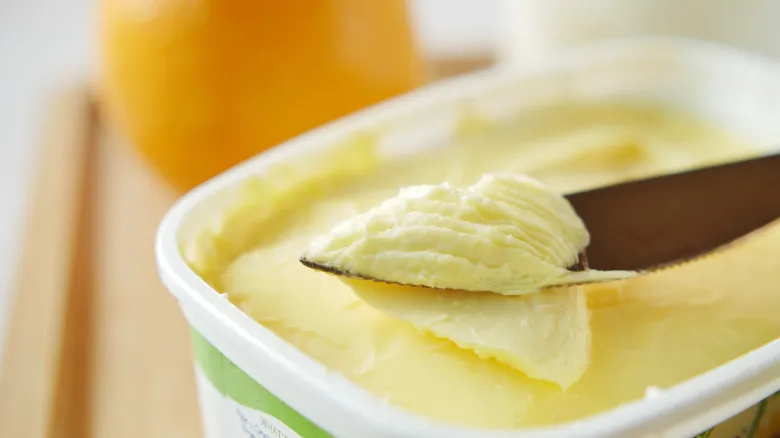
Why It's Illegal For Delaware Restaurants To Serve Margarine

The Shaky Origin Story Of The Monte Cristo Sandwich

5 Tips For Eating Korean Barbecue For An Unforgettable Meal
Next up

